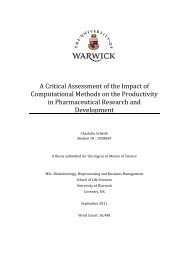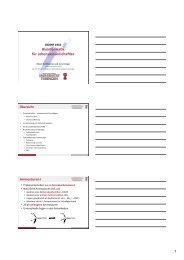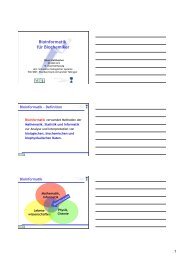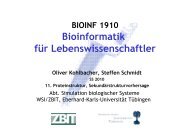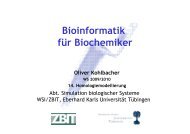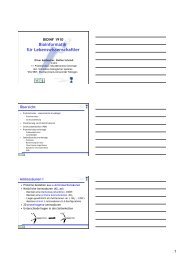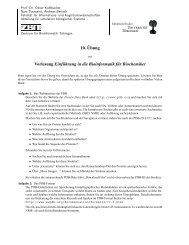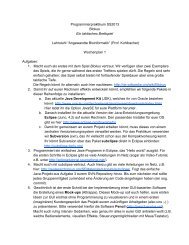Drug Design 2 - Applied Bioinformatics Group
Drug Design 2 - Applied Bioinformatics Group
Drug Design 2 - Applied Bioinformatics Group
Create successful ePaper yourself
Turn your PDF publications into a flip-book with our unique Google optimized e-Paper software.
AlogP vs. ClogP<br />
• AlogP and ClogP yield comparable performance<br />
• There are some differences with respect to molecular mass<br />
• ClogP slightly be"er for smaller molecules, AlogP for larger ones<br />
• Both methods are standard methods in computer aided-‐drug design and are<br />
being used widely<br />
PredicDon of Other ProperDes<br />
Ghose et al., J. Phys. Chem. A (1998), 102, 3762<br />
• pK a values can be predicted in a similar fashion, although<br />
performance is worse<br />
• Solubility is very difficult to predict<br />
• Based on pK a predic%on<br />
(ions usually have very nega%ve solva%on free energies)<br />
• Solva%on free energy is influenced dras%cally by the lakce<br />
energy<br />
• Predic%on of lakce energies is very tricky<br />
QSPR<br />
• Computa%onal predic%on of molecular proper%es is a field of<br />
its own within chemoinforma%cs:<br />
QSPR – Quan7ta7ve Structure-‐Property Rela7onships<br />
• The approaches discussed so far for the predic%on of log P<br />
fall into this category<br />
• A special case of QSPR is QSAR – Quan7ta7ve Structure-‐<br />
Ac7vity Rela7onships – here we try to predict<br />
pharmacological proper%es – in par%cular biological acDvity<br />
• Both approaches require an encoding of the structure in a<br />
special form (e.g., number of fragments, atoms)



